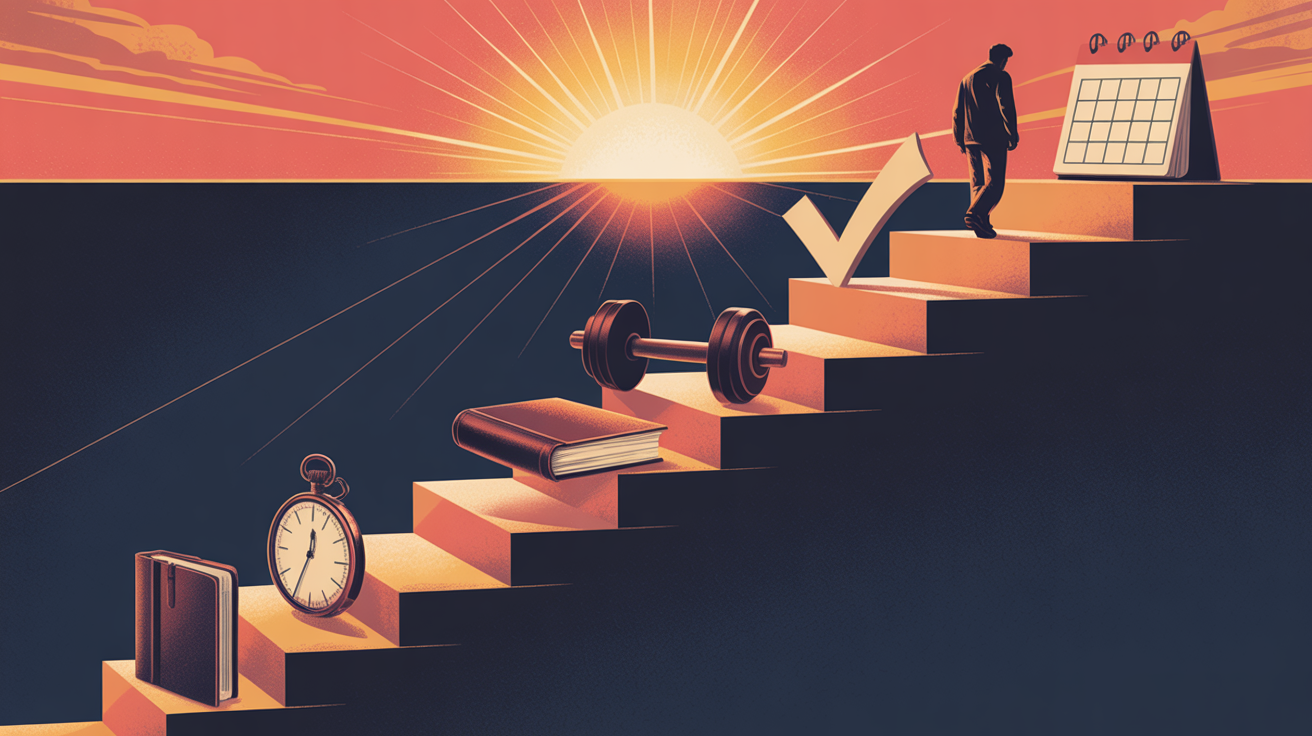
How to Practice Self-Observation Without Judgment
Self-observation sounds simple until you try it. The moment you start paying attention to your thoughts, emotions, and behaviors, that familiar inner critic shows up with commentary. Instead of neutral awareness, you find yourself caught in cycles of self-criticism and mental spirals.
Learning to observe yourself without judgment transforms how you understand and relate to yourself. This skill creates space between you and your automatic reactions, allowing for conscious choice instead of unconscious patterns. The practice leads to greater self-awareness, emotional regulation, and authentic personal growth.
True self-observation means watching yourself with the same curiosity you might have when observing a fascinating stranger. You notice what’s happening without immediately labeling it as good or bad, right or wrong. This gentle awareness becomes the foundation for meaningful change and deeper self-understanding.
Understanding the Difference Between Observation and Judgment
Judgment evaluates while observation simply notices. This distinction matters more than most people realize because judgment immediately triggers defensive reactions that cloud your ability to see clearly.
What Pure Observation Looks Like
Pure observation involves noting what’s happening in the present moment without adding stories, interpretations, or evaluations. It’s like being a scientist studying your own behavior and inner experience with genuine curiosity.
Observational thoughts sound like:
- “I notice my shoulders tensing when that topic comes up”
- “My breathing becomes shallow during this conversation”
- “I feel a knot in my stomach when I think about that deadline”
- “I’m having the thought that I’m not good enough”
- “My voice gets louder when I feel unheard”
These observations are factual and neutral. They describe what’s happening without interpretation or evaluation.
How Judgment Disguises Itself as Observation
Judgment often masquerades as observation, making it tricky to recognize. Learning to spot the difference is crucial for developing genuine self-awareness.
Judgmental thoughts that seem like observations:
- “I always get anxious in social situations” (contains “always” generalization)
- “I’m being too sensitive again” (evaluation of emotional response)
- “I should be handling this better” (comparison to imagined ideal)
- “This reaction is stupid” (harsh evaluation of natural response)
- “I’m overthinking as usual” (critical pattern-labeling)
Notice how judgment includes evaluative words like “always,” “too,” “should,” “stupid,” or “wrong.” These words immediately create internal resistance and shame.
Why Judgment Blocks Growth
Judgment triggers defensive mechanisms that prevent learning. When you criticize yourself for having certain thoughts or feelings, you create internal conflict instead of understanding. This defensive response makes it harder to see patterns clearly or make conscious changes.
Judgment also reinforces negative self-concepts. Instead of seeing behaviors as temporary responses to specific situations, judgment treats them as fixed character flaws. This creates hopelessness and resistance to change.
Self-compassionate observation, by contrast, creates safety for honest self-exploration. When you approach yourself with curiosity rather than criticism, you can examine your patterns without triggering shame or defensiveness.
The Foundation of Mindful Self-Awareness
Mindful self-awareness requires developing a different relationship with your inner experience. Instead of being caught up in thoughts and emotions, you learn to witness them with friendly attention.
Creating Inner Space
The goal isn’t to change your thoughts or emotions immediately. It’s to create some space between you and your automatic reactions. This space allows for choice and prevents you from being completely overwhelmed by intense experiences.
Think of your awareness like the sky and your thoughts and emotions like weather patterns. The sky remains vast and unchanging while clouds, storms, and sunshine pass through. You are the sky, not the weather.
This perspective helps you realize that:
- Thoughts and emotions are temporary experiences, not permanent truths
- You can observe your inner experience without being controlled by it
- Difficult feelings won’t last forever or define who you are
- You have more choice in how you respond than you might realize
Developing the Observer Self
Everyone has an inner observer that can step back and watch thoughts, emotions, and behaviors with detachment. Strengthening this observer self is like building a muscle through regular practice.
The observer self is:
- Curious rather than critical
- Present-focused rather than lost in stories about the past or future
- Accepting of what arises rather than resistant to uncomfortable experiences
- Patient with the process rather than demanding immediate change
- Gentle rather than harsh or demanding
Start by practicing observation during calm moments before applying it to challenging situations. It’s easier to develop this skill when you’re not overwhelmed by intense emotions or stress.
Distinguishing Between Experience and Story
Much of our suffering comes from the stories we tell ourselves about our experiences rather than the experiences themselves. Learning to separate direct experience from mental commentary is crucial for non-judgmental self-observation.
Direct experience includes:
- Physical sensations in your body
- Emotions as they arise and change
- Thoughts as mental events
- Environmental information through your senses
- Immediate reactions before you interpret them
Stories and interpretations include:
- Explanations for why you’re feeling something
- Predictions about what will happen next
- Comparisons to how you “should” be feeling
- Analysis of whether your response is appropriate
- Narratives about what your reactions mean about you
Practice noticing when you shift from experiencing to story-telling. Both are normal human processes, but awareness of the difference gives you more choice in how much weight to give your interpretations.
Practical Techniques for Non-Judgmental Observation
Self-observation improves with specific techniques and regular practice. These methods help you develop the skill of witnessing your inner experience with curiosity and kindness.
The RAIN Technique
RAIN provides a structured approach to observing difficult experiences without getting overwhelmed. This technique helps you stay present with challenging emotions while maintaining perspective.
R – Recognize: What is happening right now? Name the emotion, sensation, or thought without trying to change it.
A – Allow: Let the experience be present without fighting it or pushing it away. You don’t have to like it, just allow it to exist.
I – Investigate: Get curious about the experience. Where do you feel it in your body? What thoughts accompany it? What does it need?
N – Nurture: Offer yourself kindness and compassion. What would you say to a good friend experiencing this same thing?
Practice RAIN during both small irritations and larger emotional challenges. Start with minor situations to build the skill before applying it to intense experiences.
Body Scan Awareness
Your body holds tremendous wisdom about your emotional and mental state. Learning to tune into physical sensations provides valuable information about your inner experience without relying on mental analysis.
Regular body scan practice:
- Lie down or sit comfortably and close your eyes
- Start at the top of your head and slowly move your attention down through your body
- Notice areas of tension, relaxation, warmth, coolness, or other sensations
- Avoid trying to change anything you notice
- Simply observe what’s present in each part of your body
- End by noticing your overall energy and mood
Practice body scans during different emotional states to learn your unique patterns. You might notice that anxiety shows up as chest tightness while sadness feels like heaviness in your limbs.
The “Noting” Practice
Noting involves gently labeling your experiences as they arise without elaborating on them. This technique helps you observe your inner landscape without getting caught in the content of thoughts or emotions.
Common noting labels:
- “Thinking” for any mental activity
- “Feeling” for emotional experiences
- “Sensing” for physical sensations
- “Planning” for future-focused thoughts
- “Remembering” for past-focused thoughts
- “Judging” when you notice evaluative thinking
Keep the labels simple and return to observing after noting. The goal is to develop awareness of your mental processes, not to analyze or change them immediately.
Emotional Weather Reports
Create internal weather reports to describe your emotional state objectively. This technique helps you observe emotions without immediately trying to fix or understand them.
Examples of emotional weather reports:
- “Partly cloudy with scattered worry showers”
- “Sunny with building frustration storms on the horizon”
- “Foggy with low visibility and confusion”
- “Clear skies with gentle contentment breezes”
- “Stormy with high anxiety winds and criticism lightning”
This playful approach makes observation feel lighter while still providing accurate information about your inner state. It also reminds you that emotional weather, like actual weather, changes naturally over time.
Common Obstacles and How to Navigate Them
Everyone encounters challenges when learning non-judgmental self-observation. Recognizing these obstacles helps you work with them skillfully rather than getting discouraged.
The Perfectionism Trap
Many people approach self-observation with perfectionist expectations. They want to observe without any judgment whatsoever and criticize themselves when they notice critical thoughts arising.
Remember that noticing judgment is actually successful observation. The goal isn’t to never have judgmental thoughts. It’s to notice when judgment arises and return to curiosity without beating yourself up about it.
When you catch yourself judging:
- Notice the judgment without judging the judgment
- Gently redirect your attention to neutral observation
- Celebrate catching the pattern rather than criticizing yourself for having it
- Remember that this process takes time and practice to develop
Perfectionism in self-observation creates the very judgment you’re trying to avoid. Approach the practice with patience and self-compassion.
Information Overload
As you begin observing yourself more carefully, you might feel overwhelmed by how much is always happening internally. This is normal and temporary as you adjust to increased self-awareness.
Manage information overload by:
- Focusing on one aspect of experience at a time (just emotions, or just body sensations)
- Setting specific times for observation practice rather than trying to be aware all day
- Choosing quality over quantity in your observations
- Remembering that you don’t need to understand everything you notice
You don’t need to process every observation immediately. Sometimes simply noticing is enough. Understanding and change often come naturally with continued awareness.
The Analysis Paralysis
Some people get stuck in endless analysis of their observations instead of simply witnessing them. This turns observation into another form of mental activity rather than a way to step back from thinking.
Signs you’re over-analyzing:
- Spending more time thinking about your emotions than experiencing them
- Creating elaborate theories about why you react certain ways
- Feeling confused rather than clearer about your inner experience
- Getting lost in psychological explanations instead of staying present
Return to simple, present-moment awareness when you notice analysis taking over. You can always explore patterns and meanings later during designated reflection time.
Resistance to Difficult Emotions
Most people have emotions they’d rather avoid observing. Anger, sadness, fear, and shame can feel too intense or uncomfortable to witness directly.
Start with less intense experiences to build your tolerance for difficult emotions. Practice observing mild irritation before working with rage, or light sadness before deep grief.
Remember that:
- Emotions won’t intensify indefinitely if you observe them calmly
- Resistance to emotions usually creates more suffering than the emotions themselves
- All emotions have wisdom to offer if you can stay present with them
- You can always take breaks from observation if you feel overwhelmed
Seek support from therapists or counselors if you encounter trauma responses or emotions that feel unmanageable.
Applying Self-Observation to Different Life Areas
Self-observation becomes most valuable when applied to specific situations where you want to understand yourself better or create change. Different contexts require slightly different approaches.
Relationship Patterns
Observing yourself in relationships reveals patterns that are invisible when you’re focused on the other person’s behavior. This awareness can transform how you connect with others.
Notice in relationships:
- Your typical reactions to conflict or disagreement
- How your communication style changes with different people
- Physical sensations that arise during emotional conversations
- Thoughts and assumptions you make about others’ motivations
- Patterns of giving too much or too little in relationships
Focus on your own experience rather than analyzing the other person. This keeps you in your area of influence and prevents blame-focused thinking.
Work and Career Situations
Professional environments often trigger unique stress responses and behavioral patterns. Observing yourself at work can improve performance and job satisfaction.
Work-related observations:
- Energy levels throughout different tasks and times of day
- Stress responses during meetings, deadlines, or difficult projects
- Communication patterns with colleagues, supervisors, and clients
- Procrastination triggers and productivity patterns
- Physical posture and tension during various work activities
Use observations to make small adjustments rather than dramatic career changes. Sometimes minor tweaks in approach create significant improvements in work experience.
Health and Self-Care Habits
Your body provides constant feedback about your choices and lifestyle. Observing physical and mental responses to different activities helps you make choices that truly support your wellbeing.
Health-related observations:
- Energy levels after eating different foods
- Sleep quality in relation to evening activities
- Exercise effects on mood and mental clarity
- Stress responses and recovery patterns
- Seasonal or cyclical changes in wellbeing
Avoid turning health observations into rigid rules. Instead, use the information to make informed choices that honor your body’s needs and preferences.
Financial Behaviors
Money triggers intense emotions for most people, making financial self-observation particularly valuable. Understanding your money patterns can improve both financial outcomes and emotional wellbeing.
Financial observations:
- Emotional states before making purchases
- Physical sensations when thinking about money
- Spending patterns during different moods
- Avoidance behaviors around financial planning
- Thoughts and beliefs about money and worth
Observe financial behaviors without immediately trying to change spending habits. Understanding your patterns comes before sustainable change.
Building a Sustainable Practice
Self-observation works best as a gentle, consistent practice rather than an intense, sporadic effort. Creating sustainable habits ensures long-term growth and insight.
Start Small and Build Gradually
Begin with just a few minutes of intentional self-observation daily. Trying to maintain constant awareness leads to mental exhaustion and abandonment of the practice.
Simple starting practices:
- Three minutes of body awareness upon waking
- Noting your emotional state before meals
- Brief check-ins during routine activities like brushing teeth
- Observing your energy levels at the end of each day
- Weekend reflection on patterns you noticed during the week
Consistency matters more than duration. Five minutes daily creates more lasting change than hour-long sessions once a week.
Create Observation Rituals
Link self-observation to existing habits to make the practice automatic. This prevents forgetting and reduces the mental effort required to maintain the practice.
Effective ritual connections:
- Morning self-observation while drinking coffee
- Brief emotional check-ins before leaving the house
- Body awareness during commute or transition times
- End-of-day reflection while preparing for bed
- Weekend pattern review during meal preparation
Choose ritual times when you’re naturally reflective rather than rushed or distracted.
Use Technology Mindfully
Apps and reminders can support self-observation practice without becoming another source of pressure or judgment. Choose tools that enhance awareness rather than creating additional tasks.
Helpful technology uses:
- Gentle reminder notifications for check-ins
- Simple mood tracking apps that don’t require lengthy input
- Voice memos for capturing observations on the go
- Meditation apps with noting or body scan practices
- Journal apps for evening reflection
Avoid tools that make self-observation feel like work or create anxiety about missing sessions.
Track Patterns Without Obsessing
Gentle pattern tracking helps you notice trends and growth over time without becoming compulsive about data collection. The goal is insight, not perfect record-keeping.
Useful pattern tracking:
- Weekly themes or recurring situations that trigger strong reactions
- Monthly reflection on areas of growth or persistent challenges
- Seasonal awareness of energy, mood, or motivation cycles
- Yearly review of major insights and changes in self-understanding
Remember that not all patterns need to be changed. Sometimes awareness alone creates the shift you’re seeking.
Integrating Insights Into Daily Life
Self-observation becomes valuable when you can translate insights into conscious choices and behavioral changes. This integration happens naturally with continued practice, but you can support the process intentionally.
From Awareness to Choice
The space between stimulus and response is where freedom lives. Self-observation expands this space, giving you more options in how you react to challenging situations.
Practice conscious choice by:
- Pausing when you notice familiar trigger patterns
- Taking a breath before responding automatically
- Asking yourself what response would be most helpful in this situation
- Choosing actions that align with your values rather than just your impulses
- Experimenting with different responses to see what works better
Start with low-stakes situations to practice conscious choice before applying it to major life decisions.
Communicating Your Observations
Sharing your self-observations appropriately can improve relationships and create mutual understanding. This requires skill in communicating about your inner experience without making others responsible for managing it.
Effective observation sharing:
- “I notice I get defensive when this topic comes up”
- “I’m feeling overwhelmed and need a few minutes to collect myself”
- “I realize I interrupt when I get excited about ideas”
- “I tend to withdraw when I feel criticized”
- “I’m having a strong reaction and want to understand it before responding”
Focus on your experience rather than analyzing the other person’s behavior or motivations.
Setting Boundaries Based on Self-Knowledge
Self-observation reveals your authentic needs and limits. Use this information to set boundaries that support your wellbeing without needing to justify them extensively.
Boundary examples from self-observation:
- “I need quiet time in the evenings to process my day”
- “I work best with advance notice about schedule changes”
- “I can’t make good decisions when I feel pressured”
- “I need to limit social activities during stressful periods”
- “I don’t engage in conversations about sensitive topics via text”
Boundaries based on self-knowledge feel more authentic and are easier to maintain than rules imposed by others or society.
Celebrating Growth and Progress
Acknowledge improvements in self-awareness and emotional regulation, even when they’re subtle. Recognition reinforces positive changes and motivates continued practice.
Signs of progress to celebrate:
- Noticing patterns more quickly
- Having less intense reactions to familiar triggers
- Choosing responses more consciously
- Feeling more compassionate toward yourself
- Making decisions that better align with your values
- Experiencing greater emotional balance overall
Growth in self-awareness isn’t always linear. You might have breakthrough insights followed by periods where old patterns resurface. This is normal and doesn’t mean you’re going backward.
Conclusion
Learning to observe yourself without judgment is one of the most powerful skills you can develop. It creates the foundation for authentic self-knowledge, emotional intelligence, and conscious living. The practice transforms your relationship with your own experience from critical resistance to curious acceptance.
The journey of self-observation is lifelong and ever-deepening. Each layer of awareness reveals new aspects of your inner landscape. What begins as a practice for managing difficult emotions evolves into a way of living with greater presence and authenticity.
Remember that progress comes through consistency rather than perfection. Every moment of non-judgmental awareness is valuable, regardless of how often your inner critic shows up. The goal isn’t to eliminate judgment entirely but to notice it without being controlled by it.
Your willingness to observe yourself with kindness is already a profound act of self-love. This practice honors your complexity and humanity while creating space for continued growth and understanding.
Start where you are, with whatever level of awareness feels manageable today. Your future self will thank you for beginning this journey of compassionate self-discovery. The insights you gain will ripple outward into every aspect of your life, creating positive changes you can’t yet imagine.








